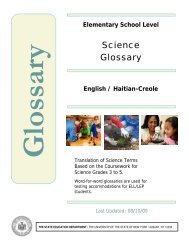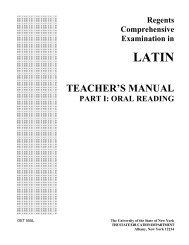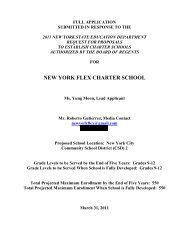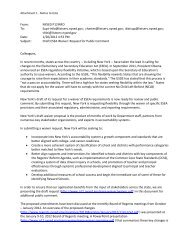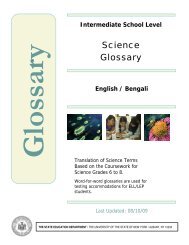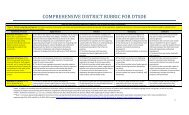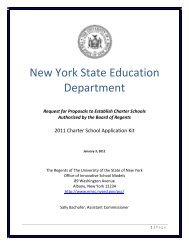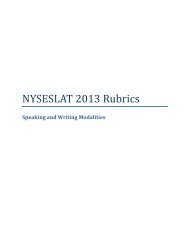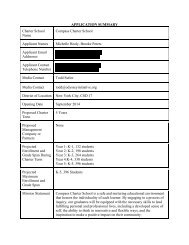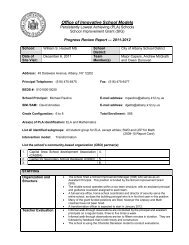- Page 1 and 2:
New York State Student Information
- Page 3 and 4:
Table of Contents iii Table of Cont
- Page 5 and 6:
Table of Contents NYSAA- and NYSESL
- Page 7 and 8:
Table of Contents Special Education
- Page 9 and 10:
Introduction Introduction The New Y
- Page 11 and 12:
Introduction New York State Educati
- Page 13 and 14:
Introduction Select Federal and Sta
- Page 15 and 16:
Introduction Select Federal and Sta
- Page 17 and 18:
Introduction Select Federal and Sta
- Page 19 and 20:
Chapter 1: Accountability in New Yo
- Page 21 and 22:
Chapter 1: Accountability in New Yo
- Page 23 and 24:
Chapter 1: Accountability in New Yo
- Page 25 and 26:
Chapter 1: Accountability in New Yo
- Page 27 and 28:
Chapter 1: Accountability in New Yo
- Page 29 and 30:
Chapter 1: Accountability in New Yo
- Page 31 and 32:
Chapter 1: Accountability in New Yo
- Page 33 and 34:
Chapter 1: Accountability in New Yo
- Page 35 and 36:
Chapter 2: Student Information Repo
- Page 37 and 38:
Chapter 2: Student Information Repo
- Page 39 and 40:
Chapter 3: nySTART Administrator: A
- Page 41 and 42:
Chapter 3: nySTART protocol (or mai
- Page 43 and 44:
Chapter 3: nySTART not case sensiti
- Page 45 and 46:
Chapter 4: Testing Rules Chapter 4:
- Page 47 and 48:
Chapter 4: Testing Rules Grade K: N
- Page 49 and 50:
Chapter 4: Testing Rules students t
- Page 51 and 52:
Chapter 4: Testing Rules Speaking/L
- Page 53 and 54:
Chapter 4: Testing Rules The school
- Page 55 and 56:
Chapter 5: Reporting Rules Chapter
- Page 57 and 58:
Chapter 5: Reporting Rules • Publ
- Page 59 and 60:
Chapter 5: Reporting Rules Reportin
- Page 61 and 62:
Chapter 5: Reporting Rules Reportin
- Page 63 and 64:
Chapter 5: Reporting Rules Reportin
- Page 65 and 66:
Chapter 5: Reporting Rules Reportin
- Page 67 and 68:
Chapter 5: Reporting Rules Reportin
- Page 69 and 70:
Chapter 5: Reporting Rules Reportin
- Page 71 and 72:
Chapter 5: Reporting Rules Reportin
- Page 73 and 74:
Chapter 5: Reporting Rules When a l
- Page 75 and 76:
Chapter 5: Reporting Rules Students
- Page 77 and 78:
Chapter 5: Reporting Rules Services
- Page 79 and 80:
Chapter 5: Reporting Rules they ref
- Page 81 and 82:
Chapter 6: Data Reporting in the SI
- Page 83 and 84:
Chapter 6: Data Reporting in the SI
- Page 85 and 86:
Chapter 6: Data Reporting in the SI
- Page 87 and 88:
Chapter 6: Data Reporting in the SI
- Page 89 and 90:
Chapter 6: Data Reporting in the SI
- Page 91 and 92:
Chapter 6: Data Reporting in the SI
- Page 93 and 94:
Chapter 6: Data Reporting in the SI
- Page 95 and 96:
Chapter 6: Data Reporting in the SI
- Page 97 and 98:
Chapter 6: Data Reporting in the SI
- Page 99 and 100:
Chapter 6: Data Reporting in the SI
- Page 101 and 102:
Chapter 6: Data Reporting in the SI
- Page 103 and 104:
Chapter 6: Data Reporting in the SI
- Page 105 and 106:
Chapter 6: Data Reporting in the SI
- Page 107 and 108:
Chapter 6: Data Reporting in the SI
- Page 109 and 110:
Chapter 6: Data Reporting in the SI
- Page 111 and 112:
Chapter 6: Data Reporting in the SI
- Page 113 and 114:
Chapter 6: Data Reporting in the SI
- Page 115 and 116:
Chapter 6: Data Reporting in the SI
- Page 117 and 118:
Chapter 6: Data Reporting in the SI
- Page 119 and 120:
Chapter 6: Data Reporting in the SI
- Page 121 and 122:
Chapter 6: Data Reporting in the SI
- Page 123 and 124:
Chapter 6: Data Reporting in the SI
- Page 125 and 126:
Chapter 6: Data Reporting in the SI
- Page 127 and 128:
Chapter 6: Data Reporting in the SI
- Page 129 and 130:
Field Number Chapter 6: Data Report
- Page 131 and 132:
Field Number Chapter 6: Data Report
- Page 133 and 134:
Field Number 33 (cont.) Chapter 6:
- Page 135 and 136:
Chapter 6: Data Reporting in the SI
- Page 137 and 138:
Chapter 6: Data Reporting in the SI
- Page 139 and 140:
Chapter 6: Data Reporting in the SI
- Page 141 and 142:
Chapter 6: Data Reporting in the SI
- Page 143 and 144:
Chapter 6: Data Reporting in the SI
- Page 145 and 146:
Chapter 6: Data Reporting in the SI
- Page 147 and 148:
Chapter 6: Data Reporting in the SI
- Page 149 and 150:
Chapter 7: Data Element Definitions
- Page 151 and 152:
Chapter 7: Data Element Definitions
- Page 153 and 154:
Chapter 7: Data Element Definitions
- Page 155 and 156:
Chapter 7: Data Element Definitions
- Page 157 and 158:
Chapter 7: Data Element Definitions
- Page 159 and 160:
Chapter 7: Data Element Definitions
- Page 161 and 162:
Chapter 7: Data Element Definitions
- Page 163 and 164:
Chapter 7: Data Element Definitions
- Page 165 and 166:
Chapter 8: Reporting Enrollment Rec
- Page 167 and 168:
Chapter 8: Reporting Enrollment Rec
- Page 169 and 170:
Chapter 8: Reporting Enrollment Rec
- Page 171 and 172:
Chapter 8: Reporting Enrollment Rec
- Page 173 and 174:
Chapter 8: Reporting Enrollment Rec
- Page 175 and 176:
Chapter 9: Reporting Program Servic
- Page 177 and 178:
Chapter 9: Reporting Program Servic
- Page 179 and 180:
Chapter 9: Reporting Program Servic
- Page 181 and 182:
Chapter 10: Reporting Students in S
- Page 183 and 184:
Chapter 10: Reporting Students in S
- Page 185 and 186:
Chapter 10: Reporting Students in S
- Page 187 and 188:
Chapter 11: Verifying Data in the S
- Page 189 and 190:
Chapter 11: Verifying Data in the S
- Page 191 and 192:
Chapter 11: Verifying Data in the S
- Page 193 and 194:
Chapter 11: Verifying Data in the S
- Page 195 and 196:
Chapter 11: Verifying Data in the S
- Page 197 and 198:
Chapter 11: Verifying Data in the S
- Page 199 and 200:
Chapter 11: Verifying Data in the S
- Page 201 and 202:
Chapter 11: Verifying Data in the S
- Page 203 and 204:
Chapter 11: Verifying Data in the S
- Page 205 and 206:
Chapter 11: Verifying Data in the S
- Page 207 and 208:
Appendices Appendices 199 Student I
- Page 209 and 210:
Appendix 1: 2010-11 Assessment and
- Page 211 and 212:
Appendix 1: 2010-11 Assessment and
- Page 213 and 214:
Appendix 3: Language Codes and Desc
- Page 215 and 216:
Appendix 3: Language Codes and Desc
- Page 217 and 218:
Appendix 3: Language Codes and Desc
- Page 219 and 220:
Appendix 3: Language Codes and Desc
- Page 221 and 222:
Appendix 3: Language Codes and Desc
- Page 223 and 224:
Appendix 4: Postgraduate Plan Codes
- Page 225 and 226:
Appendix 6: Country of Origin Codes
- Page 227 and 228:
Appendix 6: Country of Origin Codes
- Page 229 and 230:
Appendix 6: Country of Origin Codes
- Page 231 and 232:
Appendix 7: Reason for Beginning En
- Page 233 and 234:
Appendix 7: Reason for Beginning En
- Page 235 and 236:
Appendix 8: Reason for Ending Enrol
- Page 237 and 238:
Appendix 8: Reason for Ending Enrol
- Page 239 and 240:
Appendix 8: Reason for Ending Enrol
- Page 241 and 242:
Appendix 8: Reason for Ending Enrol
- Page 243 and 244:
Appendix 9: Program Service Codes A
- Page 245 and 246:
Appendix 9: Program Service Codes
- Page 247 and 248:
Appendix 9: Program Service Codes T
- Page 249 and 250:
Appendix 9: Program Service Codes P
- Page 251 and 252:
Appendix 9: Program Service Codes e
- Page 253 and 254:
Appendix 9: Program Service Codes I
- Page 255 and 256:
Appendix 9: Program Service Codes d
- Page 257 and 258:
Appendix 10: Career and Technical E
- Page 259 and 260:
Appendix 10: Career and Technical E
- Page 261 and 262:
Appendix 10: Career and Technical E
- Page 263 and 264:
Appendix 10: Career and Technical E
- Page 265 and 266:
Appendix 10: Career and Technical E
- Page 267 and 268: Appendix 11: Assessment Measure Sta
- Page 269 and 270: Appendix 11: Assessment Measure Sta
- Page 271 and 272: Appendix 11: Assessment Measure Sta
- Page 273 and 274: Appendix 11: Assessment Measure Sta
- Page 275 and 276: Appendix 11: Assessment Measure Sta
- Page 277 and 278: Appendix 13: Standard Achieved Code
- Page 279 and 280: Appendix 14: Course Codes, Grade Ty
- Page 281 and 282: Appendix 15: Preschool Students wit
- Page 283 and 284: Appendix 16: Preschool and School-A
- Page 285 and 286: Appendix 16: Preschool and School-A
- Page 287 and 288: Appendix 18: Special Education Even
- Page 289 and 290: Appendix 18: Special Education Even
- Page 291 and 292: Appendix 19: Use of SIRS Data for N
- Page 293 and 294: Appendix 19: Use of SIRS Data for N
- Page 295 and 296: Appendix 19: Use of SIRS Data for N
- Page 297 and 298: Appendix 19: Use of SIRS Data for N
- Page 299 and 300: Appendix 19: Use of SIRS Data for N
- Page 301 and 302: Appendix 20: High School Cohort Def
- Page 303 and 304: Appendix 20: High School Cohort Def
- Page 305 and 306: Appendix 20: High School Cohort Def
- Page 307 and 308: Appendix 20: High School Cohort Def
- Page 309 and 310: Appendix 20: High School Cohort Def
- Page 311 and 312: Appendix 20: High School Cohort Def
- Page 313 and 314: Appendix 21: Anticipated Changes fo
- Page 315 and 316: Appendix 21: Anticipated Changes fo
- Page 317: Appendix 21: Anticipated Changes fo
- Page 321 and 322: Appendix 21: Anticipated Changes fo
- Page 323 and 324: Appendix 21: Anticipated Changes fo
- Page 325 and 326: Appendix 22: Glossary of Acronyms S
- Page 327 and 328: Appendix 23: Glossary of Terms Inte
- Page 329 and 330: Appendix 23: Glossary of Terms •
- Page 331 and 332: Appendix 23: Glossary of Terms Neg
- Page 333 and 334: Appendix 23: Glossary of Terms a li
- Page 335 and 336: Index HSEPP, 8, 17, 58, 185, 197, 1




